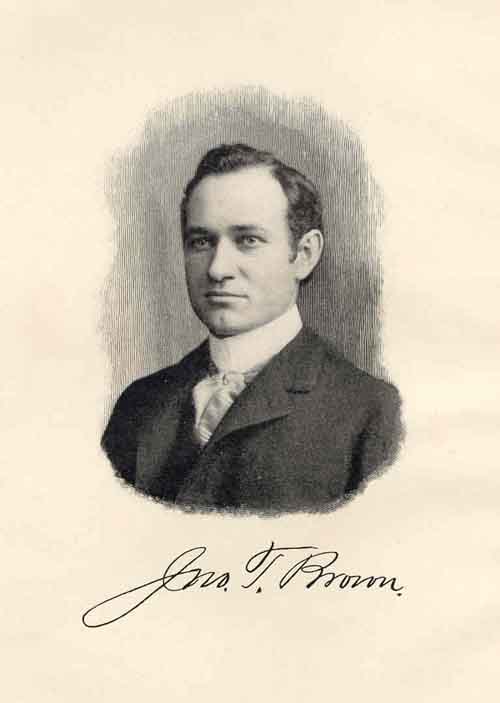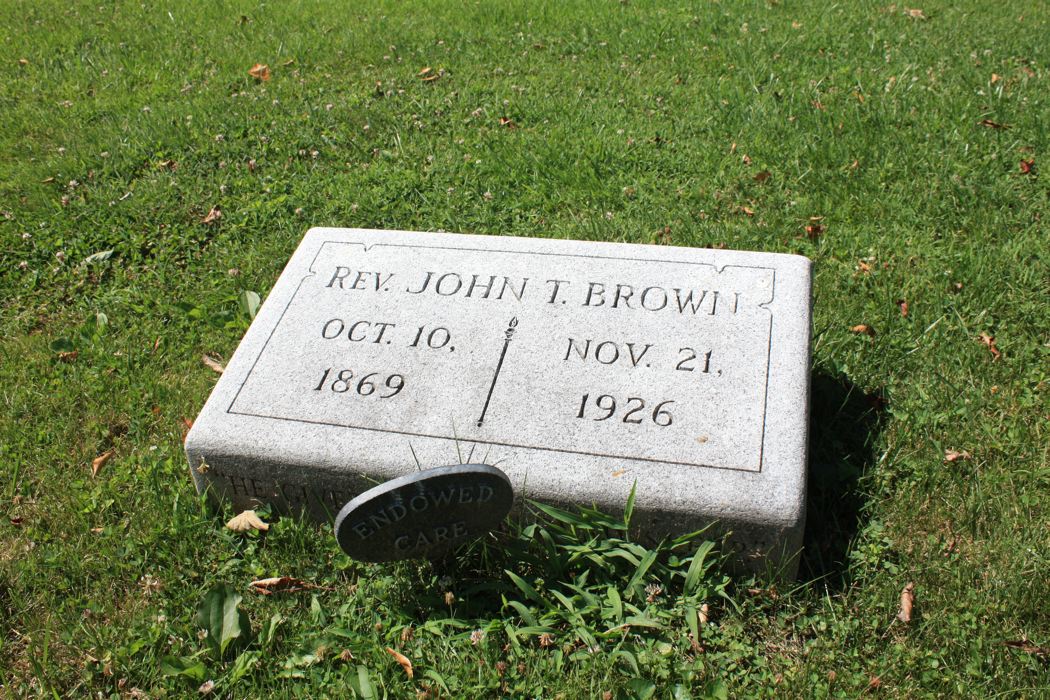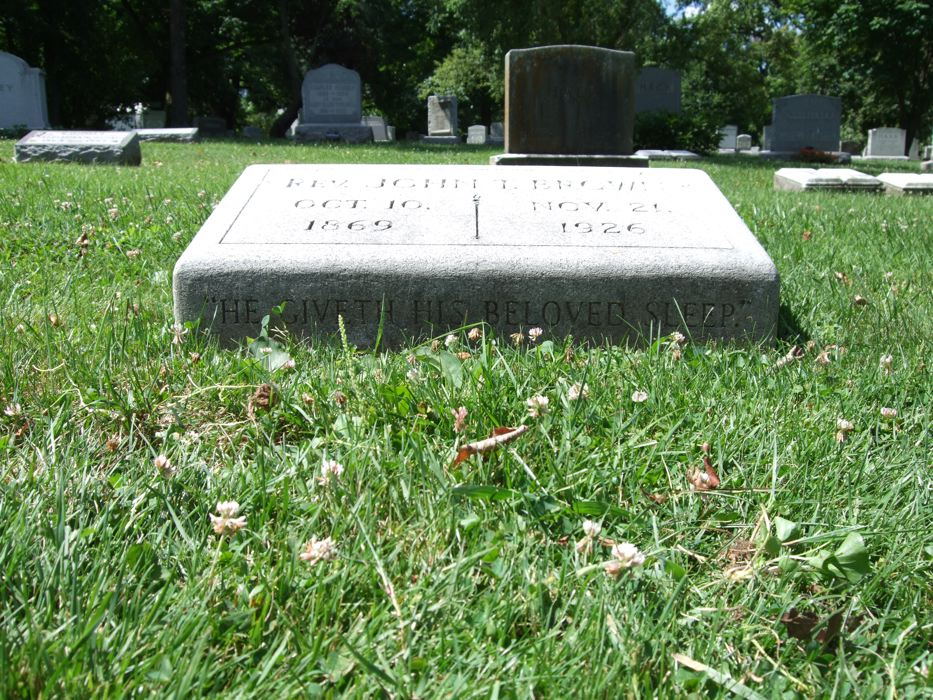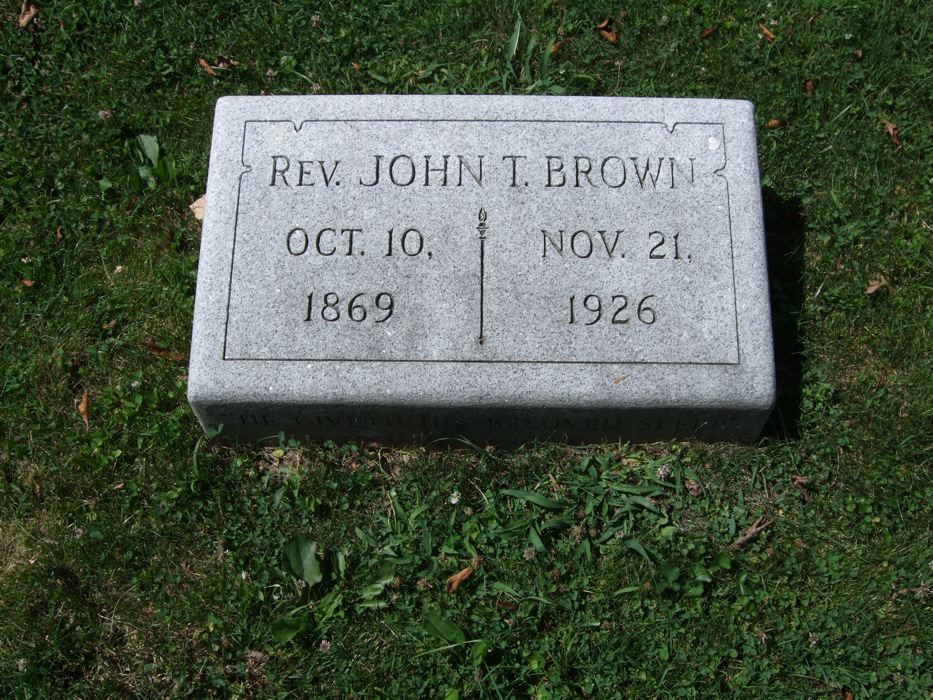John Thomas Brown
1869-1926

![]()
Sketch on the Life and Work of John T. Brown
John T. Brown, son of James M. and Susan Brown, was born one mile north of Alamo, Crockett County, Tennessee, October 10, 1869.
He was eight years old before learning his letters. His first schooling was at a little log school-house one mile southeast of his home. After attending a three months' school there he entered the public school at Alamo, but never went more than three months at a time.
At the age of fourteen, he began work with his father, who was a brick-layer. Though young in years he was grown in size, weighing one hundred and sixty-five at sixteen. He never served as an apprentice, but learned the trade so rapidly that in nine months after beginning he received the highest wages paid of a brick-mason. He helped to build the West Tennessee Insane Asylum, and spent a part of his time at Helena, Arkansas.
When he was eighteen years of age he went to Winona, Mississippi. After working there five months, he contracted to burn the brick and build a brick house for J. R. Bingham, at Carrollton, Mississippi. There was a small band of Disciples at Winona, but they had no preaching and no Sunday-school; he had never done any church work, but thought that as he was away from home he could muster up courage to attempt it. At a social service he suggested that a Sunday-school be organized, which was done, and he was elected superintendent. After several efforts to pray, he succeeded, but could only utter eight or ten words. Determined, however, to do something for the church, he was undaunted, and whenever opportunity permitted, tried to pray or speak a word for the Master.
Mr. and Mrs. J. R. Bingham, of Carrollton, where he boarded, were devout members of the Methodist Church, and he owes much of his success in life to their interest in him and their influence over him. Mr. Bingham proposed if he would take a four years' course in a Methodist college to see that it did not cost him a cent, but he replied that he did not believe in the doctrines of the Methodist Church, and that he could not be educated by that church and then preach in the Church of Christ. When he bade them good-by to enter Thompson's Classical Institute at his old home, Mr. Bingham told him that if he ever needed money to write him.
After being absent from school for years, when he was nineteen he entered Thompson's Classical Institute at Alamo, Tennessee. The following June he entered an oratorical contest and won the medal; he then taught school three months at Avery's School-house, which was two miles from his home.
In September, 1890, he entered the College of the Bible, at Lexington, Kentucky. As soon as school closed he began teaching at Avery's School-house, and taught during the summer. The following summer, after a hard year's work in school, he evangelized up to Sunday night before school opened Monday. The Bible course and the course in Kentucky University, combined, make a seven years' course. He took both of these courses, with an additional two years' course in elocution, in five years; during the five years, however, on account of ill health, he was compelled to miss one year.
In 1894 he graduated in elocution in the College of the Bible, and in 1896 received a classical diploma from the College of the Bible, and an A. B. from Centre College, now Central University, Danville, Kentucky, where he received his degree of A. M. in 1899.
During his college career at Lexington the students were allowed to preach only twice a month, and, rather than break this rule, he left Kentucky University and entered Centre College at Danville. He was trying to educate a brother and sister and had partially to support his father and mother, besides paying his own way through college.
While at Danville he preached at McCormacks and Burgin, Kentucky. At the latter place he built a six thousand dollar church during his last vacation in college, and preached there until he was called to become editor of the Christian Guide, now the Christian Companion.
After matriculating in the College of the Bible in 1890, he had three dollars left, but he had not forgotten his old trade, and hence worked at that every Saturday and earned enough to pay his board each week. He had only been in college five months until he was elected secretary and treasurer of the Adelphian Boarding Club; no freshman had ever been elected to this office before. This more than paid his way for two months.
The second year he was in college he began preaching, and while he has served some nine or ten churches, not one owes him a cent. His financial ability was shown, not only in working this way through college, but also in church work after he began preaching. In 1897 he was selected as editor of the Christian Guide, and in two years it almost doubled its circulation. In 1902, he published "Bruce Norman," and in one year's time three editions were sold. His last book is "The Guest of a Dream; or a Changed Life," which will soon be ready for delivery.
He has worked for two years on "Churches of Christ," but during that time has preached every Sunday, written most of "Bruce Norman" and the "Guest of a Dream" and edited the Christian Companion and looked after the business interests of the paper.
Mr. Brown is six feet two inches tall, has dark hair and blue eyes, and weighs one hundred and eighty-five pounds.
From the foregoing facts one would naturally infer that he is a man of strong will and undaunted courage. These qualities, added to great physical endurance, have enabled him to do the work of two or three men during the last few years. His hopefulness and his sunny disposition have also served as lubricants to the wear and tear of his strenuous life.
In his work on "Churches of Christ" he has traveled much—north, south, east, west—and is perhaps known by sight to as many of our brethren as any man among us; and he contemplates yet wider travels, for he is planning a visit to Palestine and all of our foreign mission stations, China, Japan, India, etc., in the near future. He has recently been engaged by the Southern Lyceum Bureau, of this city, to lecture next season.
While an editor, author, and man of affairs, yet there is nothing that pleases him more than to preach the Gospel of Christ; he is plain and pointed in his presentation of Scriptural truths, and always stands firmly on the "Old Foundation."
John T. Brown is a big-hearted man, as those of us who have shared so abundantly his generous and unselfish service can testify. There was never a truer friend, generous even to a fault, if such a thing is possible, and absolutely free from petty jealousies, always willing to extend a helping hand and kindly word to a struggling brother or a needy friend.
This work, the "Churches of Christ," is a monument and tribute to the brain that conceived and the indomitable will that executed it.
-George Gowen, Churches of Christ, A Historical, Biographical, and Pictorial History of Churches of Christ IN THE UNITED STATES, AUSTRALASIA, ENGLAND AND CANADA, c. 1904, pages xiii-xv
![]()
Churches of Christ
A Historical, Biographical, and Pictorial History of Churches of Christ
IN THE UNITED STATES, AUSTRALASIA, ENGLAND AND CANADA
THE AUTHOR'S STATEMENT
Two years ago I conceived the plan of getting out a biographical, historical, and pictorial encyclopedia of Churches of Christ. I consulted with a number of brethren, and all said that such a publication would be, not only interesting, but very valuable. I was assured by scores of my brethren that they would lend all assistance possible in getting out such a book. It has been a laborious undertaking. People were very slow to send in photos, and I have written sometimes as many as ten letters before receiving the photo or desired information. I traveled some twenty-five thousand miles in the interest of this publication, gathering data, photos, and taking advance orders. During the two years I traveled from the Lakes to the Gulf and from the Atlantic to the Pacific.
The work would have been more successful, no doubt, if I could have devoted all my time to it, but I had to preach every Sunday and edit the Christian Companion, hence have only given a part of my time to this special work. I have felt for some time that such a publication was needed, but was not willing to undertake the work until two years ago. The work will be prized more highly in the years that are to come than now, because it is a kind of waymark of the Restoration Movement.
It gives a history of the Movement to the present time. It also gives a number of sketches of our pioneers, our college presidents, some of our secretaries, and a number of evangelists. It was not my intention to give sketches of all who deserved them; but to mention only a few, that the church, in the future, may know something of the sacrifices of these splendid men of God, who labored earnestly and sacrificed much during the Nineteenth Century to re-establish Primitive Christianity in the world.
There are thousands of men, who are worthy and consecrated, whose names do not appear in this book. It would have been impossible to have gotten sketches from all of them. Those who are not mentioned in the book are as worthy as those who are mentioned, and there may be some, whose names are mentioned, who are not as worthy as some whose names do not appear. I have had to be my own judge, and am personally responsible for all who appear in this book. It is not as complete as I could wish, and, no doubt, has many imperfections, but I send it out on its mission, trusting and praying that it may strengthen the faith of some struggling disciple encourage all to walk closer with Christ and to be more consecrated in His service. While it is not perfect, it is the best that I could do, under all the circumstances, and I must be held responsible for its imperfections.
I desire to sincerely thank all who have assisted me in this great work, especially those whose names appear with the articles they have written. These brethren have been of untold service to me, and I will ever hold them in grateful remembrance for their assistance in getting out this publication. There are others, whose names do not appear in this book, who have given me much encouragement and assistance in publishing it. There are too many names to mention them all.
The engravings were made by the Heybach-Bush Company, of this city. They are the very best. I have returned a great many photos that were not suitable. As a rule, those I used were the very best. If there is a bad engraving in the book it is because the photo was an inferior one. I was compelled to put in some few such photos, because good ones could not be secured. It was not my intention to have engravings of all of our church buildings, but simply a few, scattered all over the world, that the reader might know something of the architecture of our buildings.
The size of the engraving has nothing to do with the importance of it. It was impossible to make all the same size, because the pictures varied in size. I have used my own judgment, in connection with that of the artist, in making some engravings larger than others.
It is my purpose to publish Volume II of Churches of Christ in 1910 (D. V.), just after our Centennial Convention, which is to be held in Pittsburg, Pa., 1909. The second volume will be somewhat supplemental to the first. Some articles and some photos, which should have appeared in this volume, are left out because I was unable to secure them, but not because of any fault of mine.
In the second volume I hope to publish, in addition to the new matter necessary, all the old material which was left out of the first.
Some of my brethren told me in the beginning that I should get out a cheap book, so that it might have a large sale. The fact is, however, that a cheap book of this kind would have had no sale at all. A cheap book of halftone engravings would not sell. The first thousand of these books will cost nearly $6,000.00, almost six dollars a volume. I believe that our people will appreciate such a publication.
My desire has been to give a faithful record of the work accomplished, and the reader will be his own judge as to how well the work has been done.
Since beginning this volume, some, whose names appear in it, have fallen asleep. Some of them wrote me some time ago that they were anxious to see the book before they were called hence, but they have gone to their reward before it could be completed. Their names are written in the "Lamb's Book of Life."
-Churches of Christ, John T. Brown, Editor's Statement, c.1904, pages xi-xii
Webeditor's Note: The above biographical sketch and Author's Statement were taken from the volume of Churches of Christ, by John T. Brown. It is my privilege to have two copies of this preservation of early church history in my library. For a free .pdf (38mg) download of the book click here. It was my privilege to visit the grave of John T. Brown while traveling through Louisville in June, 2009.
![]()
Directions To The Grave Of John T. Brown
John T. Brown is buried in the Cave Hill Cemetery in Louisville, Kentucky. The cemetery is located at 791 Baxter Ave. (Hwy. 31). From I-64 take Exit 8 and turn left (west) go to next traffic light (should be Hwy ALT-60) Should see the cemetery on the right. However you will need to enter the cemetery from the Hwy. 31-E (Baxter Ave.) entrance. Do this by staying on ALT-60 until you turn right on Hwy. 31-E (Baxter Ave.) (North) then entrance should be up on right. When entering the cemetery go to the office and get a map of the cemetery. Brown is in Section 24, Lot 182. VERY close to E.L. Jorgenson. The exact GPS location of the grave is: 38°14'48.3"N 85°42'49.1"W / or D.d. 38.246750, -85.713633
BING MAP of preacher grave locations here
![]()


"He Giveth His Beloved Sleep"

Rev. John T. Brown
Oct. 10, 1869-Nov. 21, 1926
![]()
Special Thanks
In June, 2009 Tom L. Childers, C. Wayne Kilpatrick and Scott Harp traveled about 3000 miles in one week through parts of Tennessee, Missouri, Illinois, Indiana and Kentucky. During this time we found the graves of 75 church leaders in the Restoration Movement. Chronicling these leaders into websites has been time consuming. Many thanks to Tom and Wayne in helping to take photos, share the driving, and putting up with your web master's slave-driving effort to see as many as we did in the time we had. Their photos as well as some of mine are seen on this site.
Note: If visiting the grave of John T. Brown, be sure to note that within 50 feet of the grave is the grave of E.L. Jorgenson, another preacher from the Louisville area.
![]()